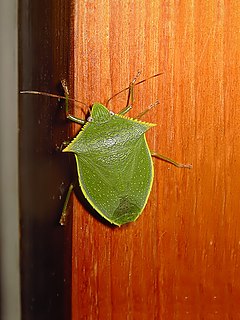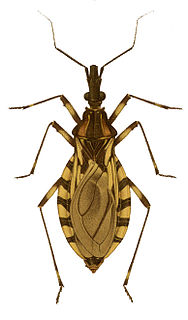 W
WBactrodes is a genus of reduviids. All known species are from South America.
 W
WBelostoma is a genus of insects in the hemipteran family Belostomatidae, known colloquially as giant water bugs. Members of this genus are native to freshwater habitats in the Americas, with the greatest species richness in tropical South America. Most species in the family Belostomatidae have historically been included in Belostoma, but several of these have been moved to other genera.
 W
WChinavia aseada is a species of plant bugs belonging to the family Pentatomidae that is endemic to Passo Fundo, Brazil.
 W
WDactylopius is a genus of insect in the superfamily Coccoidea, the scale insects. It is the only genus in the family Dactylopiidae. These insects are known commonly as cochineals, a name that also specifically refers to the best-known species, the cochineal. The cochineal is an insect of economic and historical importance as a main source of the red dye carmine. It has reportedly been used for this purpose in the Americas since the 10th century. Genus Dactylopius is also important because several species have been used as agents of biological pest control, and because several are known as invasive species.
 W
WThe fulgorid genus Fulgora contains several large Central and South American planthoppers known by a large variety of common names including lantern fly, peanut bug, peanut-headed lanternfly, alligator bug, machaca, and jequitiranaboia. The nine species are mostly similar in appearance, with differences in the shape of the head, and patterns of wing coloration. The most well-known and widespread of these species is Fulgora laternaria. They can measure as long as 3 inches. There is some confusion regarding the validity of some of the currently recognised species. The type species of Fulgora is Cicada laternaria Linnaeus 1758, designated under the Plenary Powers by ICZN. Old World species assigned to this genus belong instead to the genus Pyrops.
 W
WThe Giant cicada, also known as the chichara grande, coyoyo, or coyuyo, is a species of large cicada native to North, Central, and South America. One of two species in the genus Quesada, it is the widest ranging cicada in the Western Hemisphere.
 W
WLepidosaphes ulmi also known as apple mussel scale or oystershell scale is a scale insect that is a pest of trees and woody plants. The small insects attach themselves to bark and cause injury by sucking the tree's sap; this metabolic drain on the plant may kill a branch or the entire tree.
 W
WLeptoglossus zonatus is a species of leaf-footed bug, a type of true bugs. It is found throughout much of South America, Central America, Mexico, and the southwestern United States. The bug is two centimeters in length, gray in color, with a zigzagging whitish band across its back and two distinctive yellowish spots on its anterior pronotum, the identifying characteristic for the species.
 W
WLoxa is an insect genus in the large family of shield bugs. It occurs primarily in Central America and Mexico, but is also found in Texas, Florida and South America. While Loxa is a genus of the tribe Pentatomini, its species are similar in many respects to those in the Chlorocorini, specifically the genera: Chlorocoris Spinola, Chloropepla Stål, Mayrinia Horvath and Fecelia Stål. Some species of Loxa are minor crop pests, for example Loxa deducta.
 W
WPanstrogylus geniculatus is a blood-sucking sylvatic insect noted as a putative vector of minor importance in the transmission of Trypanosoma cruzi to humans; this is a parasite, which causes Chagas disease. The insect is described as sylvatic; subsisting primarily in humid forests, and is also known to inhabit vertebrate nesting places such as those of the armadillo, and is also involved in enzootic transmission of T. cruzi to those species. It has wide distribution throughout 16 Latin American countries.
 W
WProtopulvinaria pyriformis, commonly known as the pyriform scale, is a species of soft scale insect in the family Coccidae. It is a pest of avocado and is found in many countries around the world where avocados grow.
 W
WThasus is an insect genus of the Coreidae, or leaf-footed bugs. It is a genus in the New World Nematopodini tribe that feeds on plants. It is chiefly found in Central America, but species also occur in South America, and as far north as the American Southwest.
 W
WThaumastocoris peregrinus, the bronze bug, is a true bug first described from Argentina, but is probably native to Australia. The species has been recorded in Africa, Europe, Middle East (Israel), North America, South America, Caribbean, and New Zealand as a pest of eucalyptus.
 W
WTriatoma brasiliensis Neiva, 1911 is now considered the most important Chagas disease vector in the semiarid areas of northeastern Brazil. T. brasiliensis occurs in 12 Brazilian states, including Maranhão, Piauí, Ceará, Rio Grande do Norte, and Paraíba. T. brasiliensis is native to this part of Brazil, and thus persists in the natural environment. This species of Kissing Bug has the greatest potential to spread Chaga's disease due to its distribution over large areas where numerous people reside. Triatoma species are commonly called Kissing Bugs because they bite around the mouth where skin is thinner. T. brasiliensis also has the greatest potential to colonize new areas and spread throughout northeastern parts of Brazil. This makes control problematic.
 W
WTriatoma dimidiata is a blood-sucking insect whose range extends from northern South America, throughout all the countries of Central America and into Southern Mexico. It is among the most important carriers of Trypanosoma cruzi, the flagellate protozoa that causes Chagas disease. Dimidiata has been found in rock piles, caves occupied by bats, hollow trees occupied by mammals or birds, and other diverse ecotopes. However, their presence in human abodes is usually happenstance; people tend to bring them indoors with their firewood. When in the nymph form they may camouflage themselves from predators by scraping dust over their dorsal abdomen, a behavior also observed in T. phyllosoma, T. nigromaculata, Panstrongylus geniculatus, P. megistus and P. herreri nymphs. Moreover, due to geological past in Mesoamerica such as forest loss, and rising temperatures, there has been an increase in Triatomine bugs infestation.
 W
WTriatoma rubrovaria is an insect which is ubiquitous in Uruguay, in neighboring parts of northeastern Argentina, and in the southern states of Paraná and Rio Grande do Sul in Brazil. This species of triatomine is found mainly among exfoliate rocks known as pedregales. It was earlier reported as T. (triatoma) rubrovaria, a sylvatic species inhabiting rock piles, rarely found in human dwellings. This species may be a highly competent vector of Trypanosoma cruzi, the causative agent of Chagas disease. In Rio Grande do Sul, data from the Chagas disease Control Program have indicated an increasing of domiciliary and peridomiciliary invasion of T. rubrovaria, where it has become the most frequently triatomine species captured in that State since the control of T. infestans.
 W
WUmbonia spinosa is a species of Membracidae native to South America.